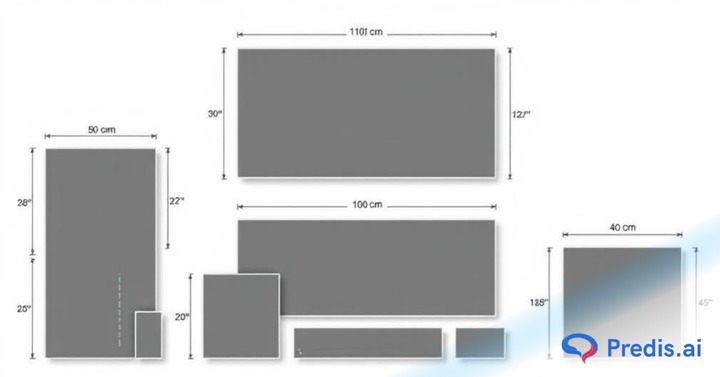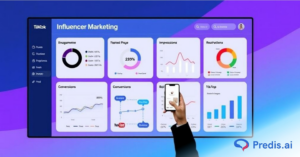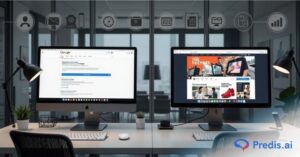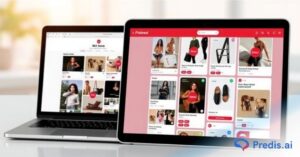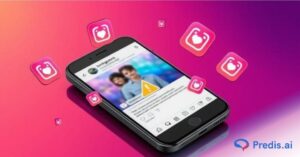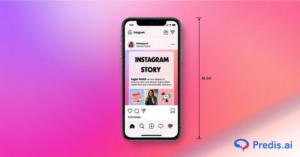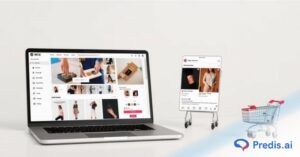With the rise of internet connectivity, social media platforms, and, most of all, search engine usage, the marketing landscape has evolved tremendously towards display campaigns. Now essential for businesses to drive lead generation, revenue, and brand awareness effectively, the ideal positioning for display campaigns to showcase products is when done in tandem with relevant webpage content.
In 2024, this ad distribution is being accomplished quite effectively with the help of search engine networks such as the Google Display Network (GDN). GDN places your banner ads on websites that your target audience will likely visit based on their interests, demographics, and online behavior.
With a tremendous reach of over 90% of internet users worldwide, it is imperative to nail key elements that could sway the impact of your Google ads. One element that often remains a silent driver is selecting the right Google banner ad sizes. Considering that Google banner ad sizes have the potential to amplify your ad content severalfold by boosting visibility, CTRs, and conversion rates, businesses often need a more comprehensive understanding of what ad sizes are available and how to deploy them.
This article will explore popular Google banner ad sizes and their advantages. So, let’s get right to it!
The Most Popular and Effective Google Banner Ad Sizes
Here are the most popular ad sizes, which consistently deliver strong results across various campaigns, making them a go-to choice for many advertisers. To help you understand what each size offers, we have also jotted down its most significant pros and cons.
Remember, the dimensions provided are pixel-width by height.
1. Medium Rectangle
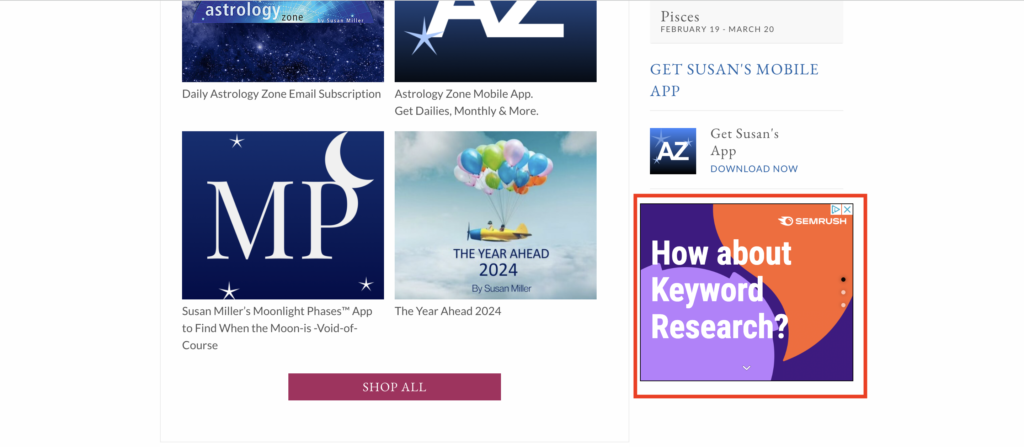
This is one of the most versatile Google banner ad sizes. It frequently appears within text content, at the end of articles, or in sidebars. The medium rectangle is ideal for a balanced mix of images and text showcasing product features or promotions.
- Pros: Excellent for brand awareness and direct response campaigns, high viewability.
- Cons: Can get lost on visually busy pages.
2. Billboard
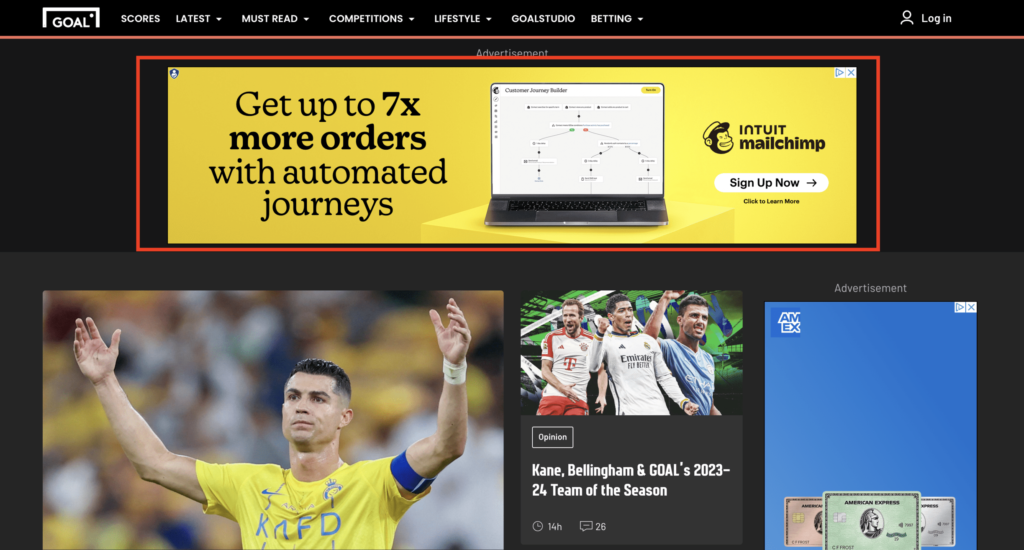
The billboard is displayed at the top of a webpage and is quite large compared to other banner ads. As it commands significant attention, it is ideal for high-impact branding campaigns with solid visuals and a clear message.
- Pros: High visibility across desktops, good for brand awareness.
- Cons: Limited availability, can be expensive compared to other sizes.
3. Leaderboard
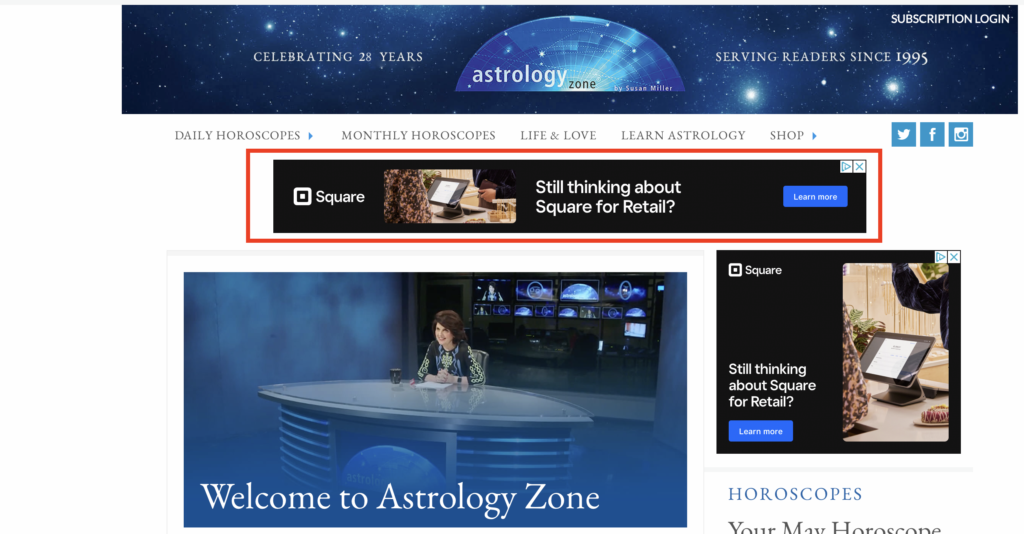
The leaderboard is displayed across the top of websites, above the main content. It is an ad size that focuses on brand awareness and broad reach. Its long horizontal form is suitable for image-heavy designs with a strong headline.
- Pros: High visibility, ideal for reaching a large audience.
- Cons: It can be easily overlooked if not crafted to be visually compelling.
4. Half Page
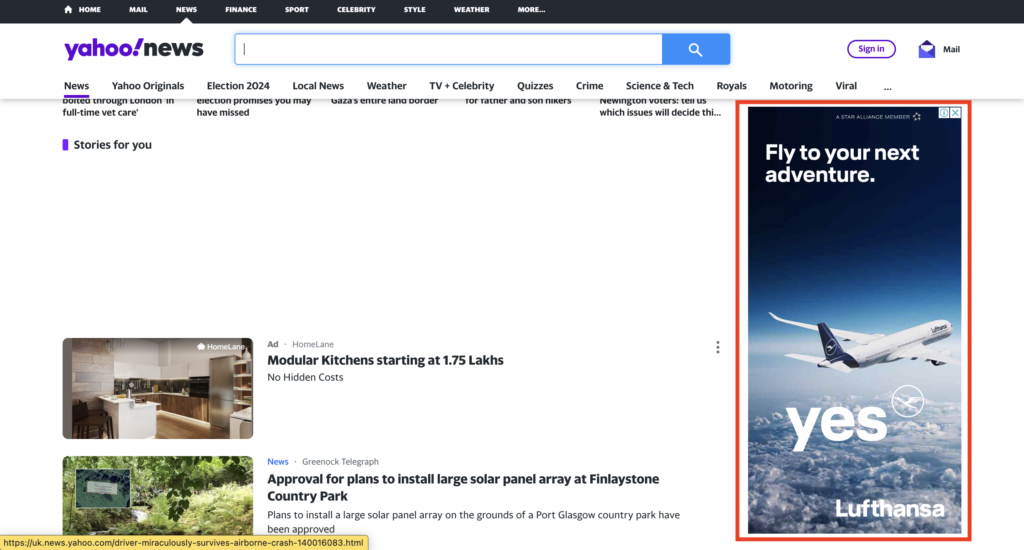
The half-page ad size runs alongside content or in the sidebar, taking up significant vertical space. The form is perfect for storytelling, product demonstrations, or displaying multiple products.
- Pros: High impact, more room for creativity.
- Cons: May not fit well on all screen sizes, especially mobile.
5. Large Mobile Banner
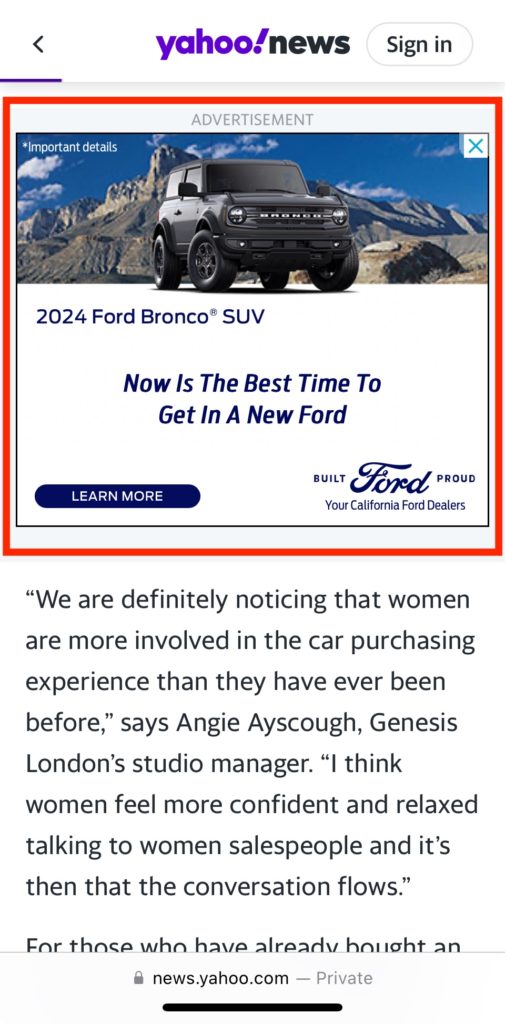
The large mobile banner ad size often appears at the top or bottom of the screen for content pages optimized for mobile devices. It is perfect for content that is kept simple yet visually appealing. This ad size does best with a clear call to action, considering that the size is smaller yet takes up space when viewers are on mobile devices.
- Pros: Essential for reaching mobile users, high engagement potential.
- Cons: Smaller canvas limits creative options
Along with these popular ad sizes, here are some additional standard ad size options for reaching your target audience and diversifying your ad placements.
6. Wide Skyscraper
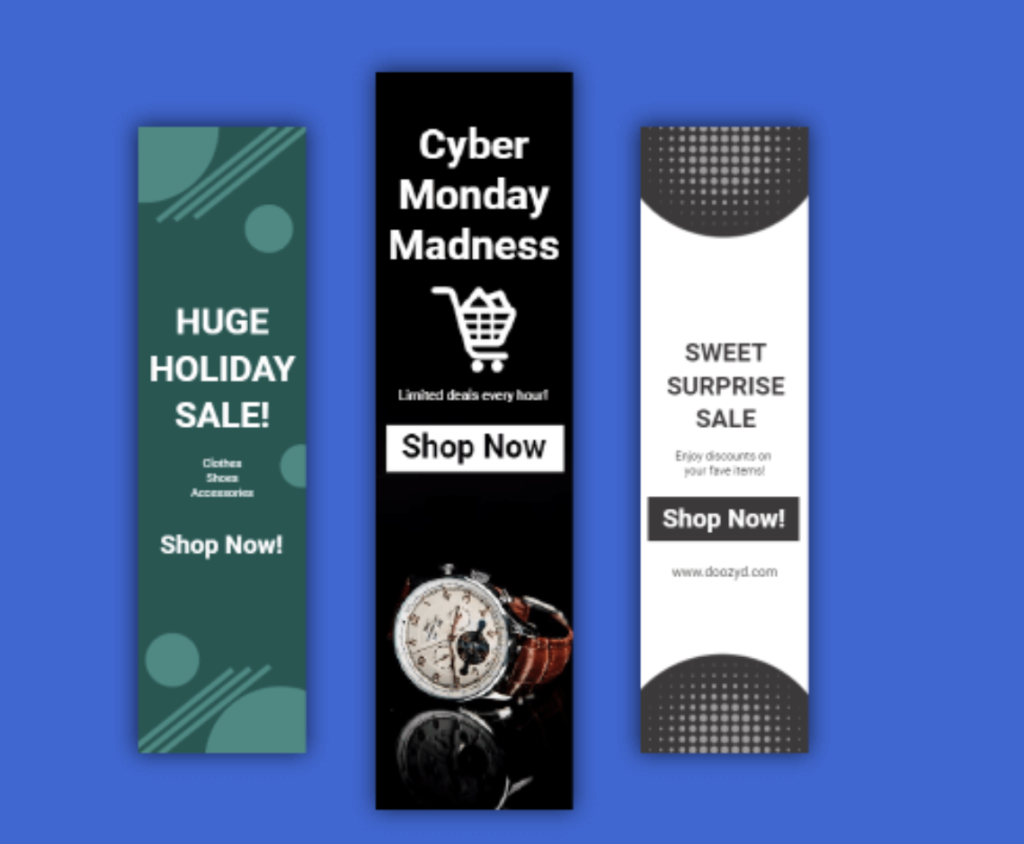
This form is primarily found in website sidebars, complementing the main content. The wide skyscraper is well-suited for text-heavy ads or showcasing a single product with a strong benefit.
- Pros: Offers space ideal for messaging, suitable for lead generation.
- Cons: Limited visibility compared to larger sizes may not be ideal for image-focused creatives.
7. Square
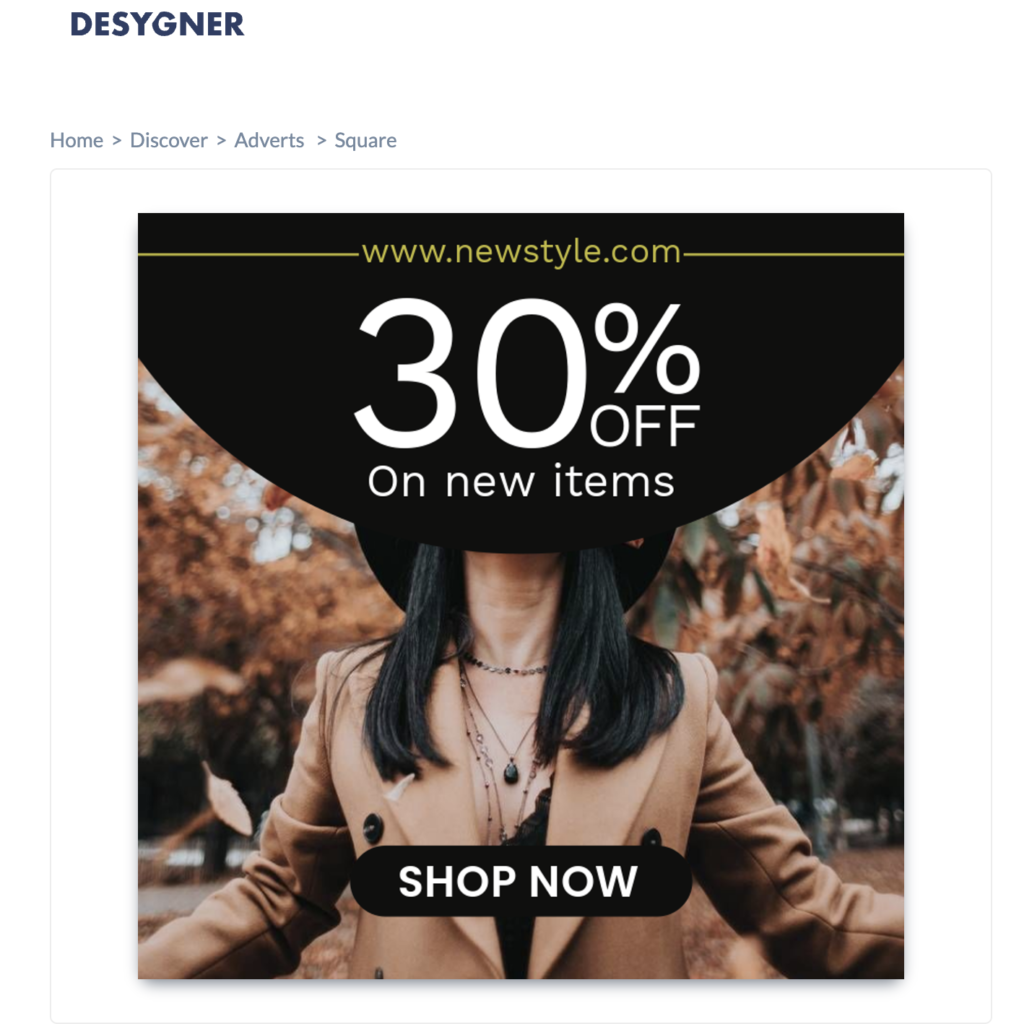
This ad size is known to be quite versatile and can appear in various locations like sidebars, within content, or even footer sections. Square banner ads work well for crisp visuals with a short message or logo display.
- Pros: Flexible placement options, suitable for brand recognition.
- Cons: Limited space for detailed information and lower click-through rates compared to larger sizes.
8. Mobile Leaderboard
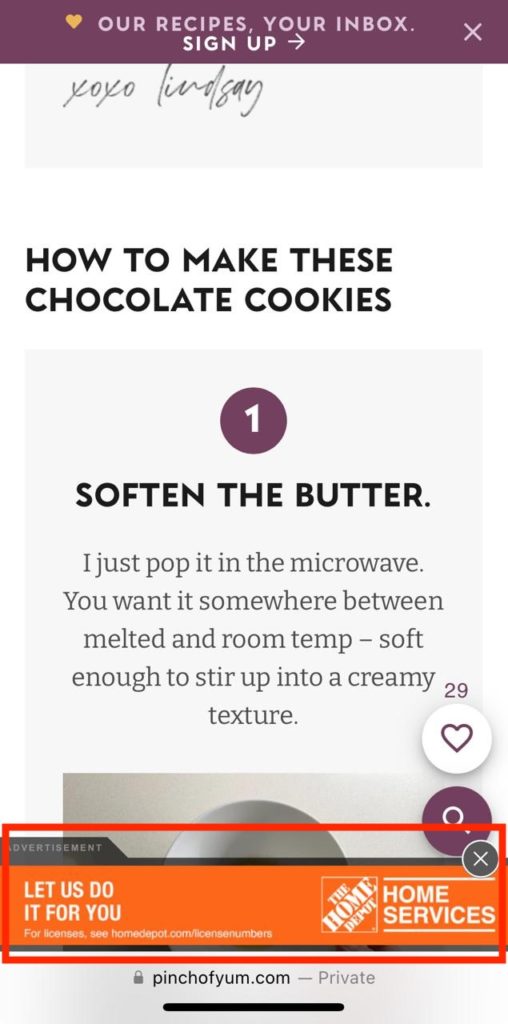
Another format optimized for mobile devices is the mobile leaderboard, which is displayed across the top of the mobile page screen, similar to the desktop leaderboard. The content must be concise and attention-grabbing and should prioritize a clear call to action.
- Pros: Reaches mobile users effectively, making it ideal for app downloads or promotions.
- Cons: Very limited space for content, requires careful design.
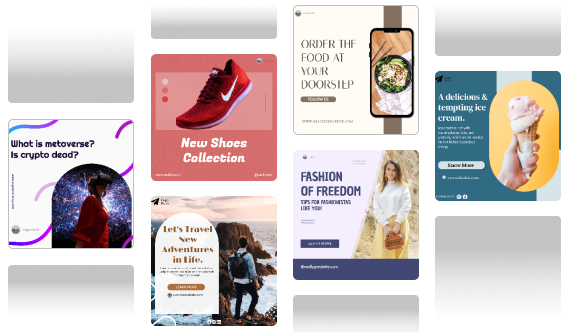
What to Consider While Choosing Google Banner Ad Sizes?
Here are five things you must consider to help you decide which of the various Google banner ad sizes best fits you.
1. Campaign Goals
The first aspect to be considered when selecting from Google banner ad sizes is what you want to achieve.
Consider larger ad formats like the leaderboard, half-page, or billboard to increase brand visibility and reach. Focus on sizes known for high click-through rates (CTRs), like the medium and large rectangles, to drive clicks, conversions, or specific actions. These sizes are often placed within content, which users are likelier to notice and engage with.
2. Target Audience
Apart from your goals, audience demographics and the intended device also play a massive role in deciding the right Google banner ad sizes.
Considering the target audience’s age, interests, and online behavior, a younger audience is often more receptive to content optimized for mobile usage. This would make the large mobile banner a perfect fit. With Predis.ai‘s AI platform, you can share input on audience demographics with just a few clicks before generating content.
3. Website Placement
Website placement is one of the main drivers of visibility next to content typesetting. Your choice of Google banner ad sizes will differ based on where you want viewers to spot your advertisement.
The leaderboard is the ideal choice for the top of a webpage. While this ad size has higher visibility, it may also be more prone to banner blindness when the content does not blend well with the web content.
The versatile medium rectangle is quite popular for integrating ads within articles or blog posts. These tend to have higher engagement rates as they blend in with the content. The wide skyscraper should be your go-to choice if you’re looking for sidebar placement. While sidebar ads effectively capture attention, they may have lower CTRs than in-content placements.
4. Creative Assets
Different Google banner ad sizes become more compatible depending on the creative assets you wish to use and complement your ad goals.
If you have solid and high-quality images, the ideal Google banner ad sizes are the half-page or leaderboard. These sizes can showcase visuals more effectively. Ad sizes like wide skyscrapers and large rectangles provide more space for text-heavy ads or detailed messaging.
Create stunning Display Ads effortlessly using Predis.ai’s Google Display Ads Maker. Turn text into engaging Google Display Ads with AI.
5. Testing and Optimization
Selecting Google banner ad sizes should not be done blindfolded. It’s crucial to test different ad sizes within your campaign to see which ones resonate best with your audience. Only by experimenting with various combinations of sizes and placements can you find the optimal mix.
Make use of Predis.ai‘s A/B testing-friendly content and key metrics like impressions, CTRs, and conversion rates. Use these insights to refine your ad strategy over time.
6. Benchmarks and Policies
Another factor to consider while choosing from Google banner ad sizes is the relevant benchmarks and guideline policies.
Industry benchmarks are created to ensure that your content is on the right track and is delivered in a manner audiences respond to. Abiding by specific size restrictions and the Google Display Network guidelines ensures your ads are eligible for placement.
Predis.ai‘s integration into Google’s business network allows for seamless content designs that consider all relevant regulations.
Key Tips for Content Within Every Banner Ad Size
While selecting the right ad size plays a huge role in enhancing the impact of your display campaign, here are the four tips you must have in your ad content.
- Establish a Clear Visual Hierarchy: Guide the viewer’s eye through your ad by strategically using size, color, and contrast to highlight your brand logo, headline, body copy, and call to action.
- Strong Call-to-Action (CTA): Use contrasting colors, bold fonts, and personalized language to make your CTA stand out and encourage interaction. A smart strategy would be to experiment with CTA ideas that you use on platforms such as Instagram to understand what works best.
- Concise Messaging: Keep your headline enticing and your body copy short, persuasive, and focused on the essentials.
- High-Quality Media: Use high-resolution images or videos that resonate with your target audience.
- File Compatibility: Adhere to Google’s format (JPG, PNG, GIF, MP4, WebM) and size (max 150KB) requirements to ensure optimal performance and user experience.
Banner Ad Sizing for Maximum Impact
With the detailed overview of Google banner ad sizes that we’ve covered, the choice of ad size is much clearer. Additionally, incorporating considerations and elements like your visual hierarchy and choice of creative assets further boosts the quality of your final banner ad.
It is suggested that you involve experts in your fray to ensure that your content remains effective and consistent. Predis.ai is the ideal platform if you’re looking to create quality banner ads without extensive investments.
The Predis.ai Google Display Ads Maker allows you to create banner ads optimized for your ideal Google banner ad sizes, maintain consistent brand messaging, and deliver dynamic visuals. Predis.ai‘s AI-powered tool also saves you time through bulk ad generation and streamlines the editing process with an in-built editing tool.
Use Predis.ai to choose from 10,000+ templates or create eye-catching display ads from scratch with just a few lines of text and a couple of clicks.
Related Content,


